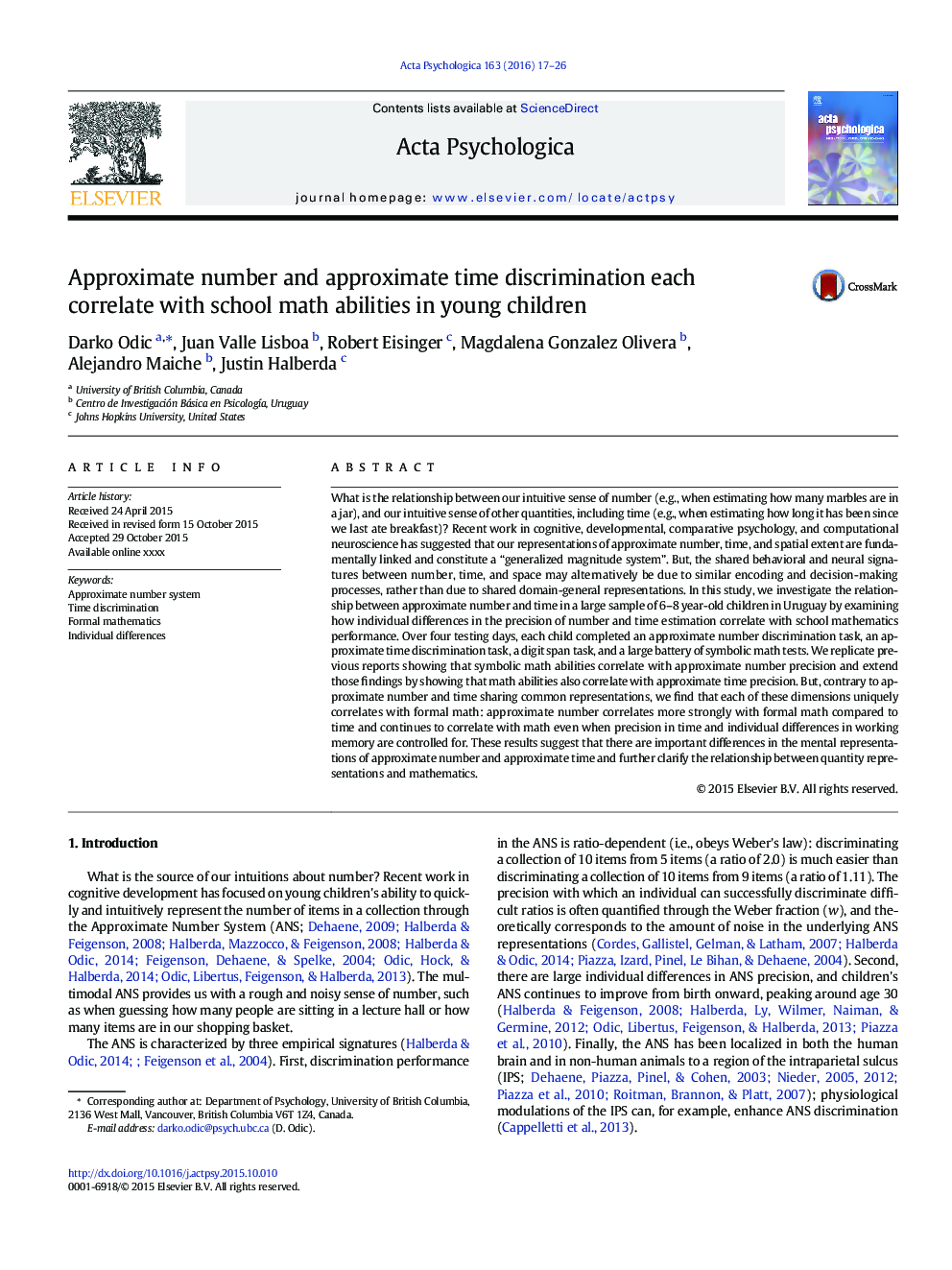| کد مقاله | کد نشریه | سال انتشار | مقاله انگلیسی | نسخه تمام متن |
|---|---|---|---|---|
| 7277114 | 1473595 | 2016 | 10 صفحه PDF | دانلود رایگان |
عنوان انگلیسی مقاله ISI
Approximate number and approximate time discrimination each correlate with school math abilities in young children
ترجمه فارسی عنوان
تعداد تقریبی و تقسیم زمان تقریبی هر یک با توانایی های ریاضی مدرسه در کودکان جوان ارتباط دارد
دانلود مقاله + سفارش ترجمه
دانلود مقاله ISI انگلیسی
رایگان برای ایرانیان
کلمات کلیدی
سیستم تقریبی تعداد، تبعیض زمان، ریاضیات رسمی، تفاوتهای فردی،
ترجمه چکیده
رابطه بین معنای شهودی ما (به عنوان مثال، هنگام برآورد اینکه چند ماربل در یک کاسه قرار دارد) و حس شهودی ما از مقادیر دیگر، از جمله زمان (به عنوان مثال، هنگام برآورد اینکه چه مدت از زمان آخرین خوردن صبحانه) ؟ کارهای اخیر در روانشناسی شناختی، توسعه، روانشناسی مقایسهای و علوم اعصاب محاسباتی نشان داده است که بازنماییهای ما از تعداد تقریبی، زمان و محدوده فضایی اساسا مرتبط است و یک سیستم بزرگ متمرکز است. اما، امضاهای رفتاری و عصبی مشترک بین تعداد، زمان و فضا ممکن است به روش متفاوتی به دلیل فرایندهای رمزگذاری و تصمیم گیری مشابه باشد، نه به دلیل نمایه های مشترک دامنه. در این مطالعه، رابطه بین تعداد تقریبی و زمان در نمونه ای بزرگ از کودکان 6-8 ساله یک ساله در اروگوئه بررسی شده است، با بررسی اینکه چگونه تفاوت های فردی در دقت برآورد تعداد و زمان با ریاضیات مدارس ارتباط دارد. بیش از چهار روز آزمایش، هر کودک یک وظیفه تبعیض تقریبی عددی را انجام داد، یک کار تقسیم زمان تقسیم زمان، یک کارکرد عددی و یک باتری بزرگ از آزمونهای ریاضی نمادین. ما گزارش های قبلی را نشان می دهیم که نشان می دهد توانایی های ریاضی نمادین با دقت عددی تقریبی ارتباط دارد و این یافته ها را با نشان دادن توانایی های ریاضی نیز با دقت زمان تقریبی همبسته می کند. اما بر خلاف تعداد تقریبی و زمان به اشتراک گذاری بازنمایی های عمومی، می بینیم که هر یک از این ابعاد منحصر به ریاضیات رسمی مرتبط است: تعداد تقریبی با ریاضی رسمی نسبت به زمان همبستگی بیشتری دارد و همچنان با ریاضی همبستگی دارد حتی زمانی که دقت در زمان و تفاوت های فردی در حافظه کاری کنترل می شوند. این نتایج نشان می دهد که تفاوت های مهمی در بازنمایی های ذهنی از تعداد تقریبی و زمان تقریبی وجود دارد و رابطه بین بازنمایی های کمیته و ریاضیات بیشتر روشن است.
موضوعات مرتبط
علوم زیستی و بیوفناوری
علم عصب شناسی
علوم اعصاب شناختی
چکیده انگلیسی
What is the relationship between our intuitive sense of number (e.g., when estimating how many marbles are in a jar), and our intuitive sense of other quantities, including time (e.g., when estimating how long it has been since we last ate breakfast)? Recent work in cognitive, developmental, comparative psychology, and computational neuroscience has suggested that our representations of approximate number, time, and spatial extent are fundamentally linked and constitute a “generalized magnitude system”. But, the shared behavioral and neural signatures between number, time, and space may alternatively be due to similar encoding and decision-making processes, rather than due to shared domain-general representations. In this study, we investigate the relationship between approximate number and time in a large sample of 6-8Â year-old children in Uruguay by examining how individual differences in the precision of number and time estimation correlate with school mathematics performance. Over four testing days, each child completed an approximate number discrimination task, an approximate time discrimination task, a digit span task, and a large battery of symbolic math tests. We replicate previous reports showing that symbolic math abilities correlate with approximate number precision and extend those findings by showing that math abilities also correlate with approximate time precision. But, contrary to approximate number and time sharing common representations, we find that each of these dimensions uniquely correlates with formal math: approximate number correlates more strongly with formal math compared to time and continues to correlate with math even when precision in time and individual differences in working memory are controlled for. These results suggest that there are important differences in the mental representations of approximate number and approximate time and further clarify the relationship between quantity representations and mathematics.
ناشر
Database: Elsevier - ScienceDirect (ساینس دایرکت)
Journal: Acta Psychologica - Volume 163, January 2016, Pages 17-26
Journal: Acta Psychologica - Volume 163, January 2016, Pages 17-26
نویسندگان
Darko Odic, Juan Valle Lisboa, Robert Eisinger, Magdalena Gonzalez Olivera, Alejandro Maiche, Justin Halberda,
